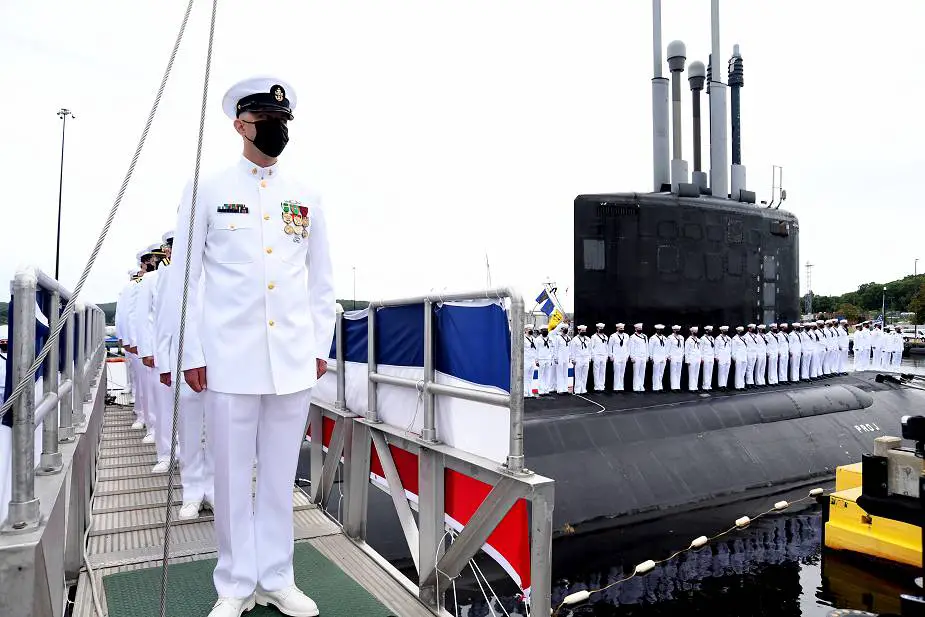According to information released by the U.S. Navy on August 28, 2021, the United States Navy celebrated the commissioning of USS Vermont (SSN 792), the first Block IV Virginia-class submarine to enter service, Saturday, August 28, 2021, at Naval Submarine Base New London.
Follow Navy Recognition on Google News at this link
 The crew of the U.S. Navy USS Vermont (SSN 792) man the rails during a commissioning commemoration for the USS Vermont (SSN 792) onboard Naval Submarine Base New London in Groton, Conn., August 28, 2021. (Picture source U.S. Navy)
The crew of the U.S. Navy USS Vermont (SSN 792) man the rails during a commissioning commemoration for the USS Vermont (SSN 792) onboard Naval Submarine Base New London in Groton, Conn., August 28, 2021. (Picture source U.S. Navy)
The USS Vermont (SSN 792) was administratively commissioned on April 18, 2020, but due to restrictions on large gatherings because of the COVID-19 pandemic at the time, no traditional commissioning ceremony was held. The submarine Vermont was christened in a traditional ceremony at General Dynamics’ Electric Boat shipyard in Groton, Connecticut, on Oct. 20, 2018. Since its administrative commissioning, USS Vermont has been an active submarine in the U.S. Navy, including participation in anti-submarine warfare exercises alongside the Brazilian navy in the U.S. 4th Fleet area of operations in December of 2020.
The USS Vermont (SSN-792) is a Virginia-class nuclear powered attack submarine in service with the United States Navy. The submarine is 377 feet long (115 m), has a 34-foot beam (10.4m) and will be able to dive to depths greater than 800 feet (244 m) and operate at speeds in excess of 25 knots (46 km/h) submerged. She has a crew of more than 130 personnel.
Fast-attack submarines are multi-mission platforms enabling five of the six Navy maritime strategy core capabilities – sea control, power projection, forward presence, maritime security, and deterrence. They are designed to excel in anti-submarine warfare, anti-ship warfare, strike warfare, special operations, intelligence, surveillance and reconnaissance, irregular warfare and mine warfare. Fast-attack submarines project power ashore with special operations forces and Tomahawk cruise missiles in the prevention or preparation of regional crises.
The Virginia, also known as the SSN-774, is a class of nuclear-powered cruise missile fast-attack submarines, in service in the United States Navy. Designed by General Dynamics's Electric Boat (EB) and Huntington Ingalls Industries, the Virginia-class is the United States Navy's latest submarine model, which incorporates the latest in stealth, intelligence gathering, and weapons systems technology.
Block IV Virginia-class submarines incorporate design changes focused on reduced total ownership cost. By making these smaller-scale design changes to increase the component-level lifecycle of the submarine, the U.S. Navy will increase the periodicity between depot maintenance availabilities and increase the number of deployments. The Block V involves 10 boats and will incorporate the Virginia Payload Module (VPM), which would give guided-missile capability when the SSGNs are retired from service. The Block V subs are expected to triple the capacity of shore targets for each submarine.
Currently, the U.S. Navy has a total of 19 Block I to IV Virginia-class submarines and it is planned to acquire 9 Block IV and 10 Block V. Blocks I-III Virginia-class submarines are planned to undergo four depot maintenance availabilities and conduct 14 deployments. Block IV design changes are intended to reduce planned availabilities by one to three, and increase deployments to 15.



